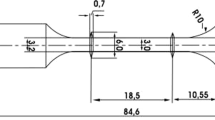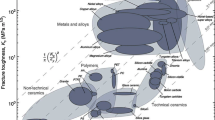The ultimate strength of diatomite in compression was studied as a function of temperature in the range 50 – 700°C. The ultimate strength in compression at temperature 450 – 500°C is approximately a factor of 2 greater than the strength under normal conditions. This makes it possible to organize the process of heating diatomite-based lining of high-temperature furnaces more efficiently.


Similar content being viewed by others
References
Rules for Technical Operation of Electric Power Plants and Grids [in Russian], Approved by order No. 247 of the Ministry of Energy of the Republic of Kazakhstan on March 30, 2015.
A. K. Kinzhebekova, Methods of Investigating the Brickwork High-Capacity Boilers [in Russian], Innovational Eurasian University, Pavlodar (2015).
A. S. Nikiforov, E. V. Prikhod’ko, and A. E. Karmanov, “Physical modeling of the heating up of linings of high-temperature furnaces,” Energ. Topl. Resursy Kazakhstana, No. 9 – 10, 88 – 89 (2012).
I. A. Shishkov (ed.), Construction of Industrial Furnaces [in Russian], Stroiizdat, Moscow (2007).
Timing Instructions for Drying the Brickwork of Land-Type Boilers in TPP [in Russian], Soyuztekhenergo, Moscow (1980).
A. Nikiforov, E. Prikhod’ko, A. Kinzhibekova, and A. Karmanov, “Investigation of the ultimate strength of periclase-carbon refractory materials and analysis of their high temperature strength,” Steklo Keram., No. 4, 32 – 35 (2014); A. Nikiforov, E. Prikhod’ko, A. Kinzhibekova, and A. Karmanov, “Investigation of the ultimate strength of periclase-carbon refractory materials and analysis of their high temperature strength,” Glass Ceram., 73(3 – 4), 137 – 139 (2014).
E. V. Prikhod’ko, A. S. Nikiforov, and I. V. Shanov, “Method of thermomechanical testing of materials and an apparatus for implementing it, Republic of Kazakhstan Innovation Patent No. 21807,” Byull. Izobr. Polezn. Modeli, No. 10 (2009), published October 15, 2009.
V. E. Manevich, R. K. Subbotin, E. A. Nikiforov, et al., “Diatomite—siliceous material for the glass industry,” Steklo Keram., No. 5, 34 – 39 (2012); V. E. Manevich, R. K. Subbotin, E. A. Nikiforov, et al., “Diatomite — siliceous material for the glass industry,” Glass Ceram., 69(5 – 6), 168 – 172 (2012).
V. P. Selyaev, V. A. Neverov, O. G. Mashtaev, and A. V. Kolotushkin, Magazine Civil Eng., No. 7, 15 – 25 (2013).
S. E. Ivanov and A. V. Belyakov, “Diatomite and its applications,” Steklo Keram., No. 2, 18 – 21 (2008); S. E. Ivanov and A. V. Belyakov, “Diatomite and its applications,” Glass Ceram., 65(1 – 2), 48 – 51 (2008).
Author information
Authors and Affiliations
Corresponding author
Additional information
Translated from Steklo i Keramika, No. 2, pp. 24 – 26, February, 2018.
Rights and permissions
About this article
Cite this article
Nikiforov, A.S., Prikhod’ko, E.V., Kinzhibekova, A.K. et al. Heat-Engineering Characteristics of Diatomaceous-Earth Materials in a Wide Temperature Range. Glass Ceram 75, 60–62 (2018). https://doi.org/10.1007/s10717-018-0029-2
Published:
Issue Date:
DOI: https://doi.org/10.1007/s10717-018-0029-2




